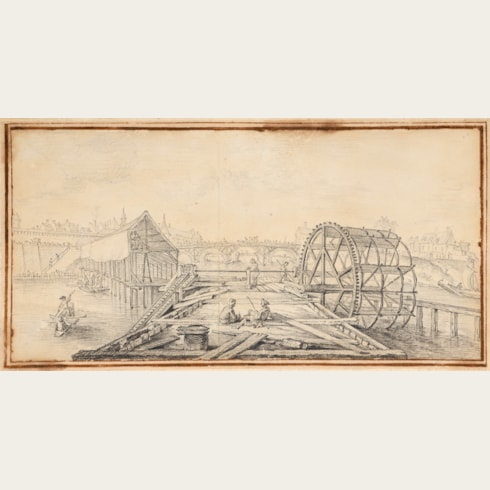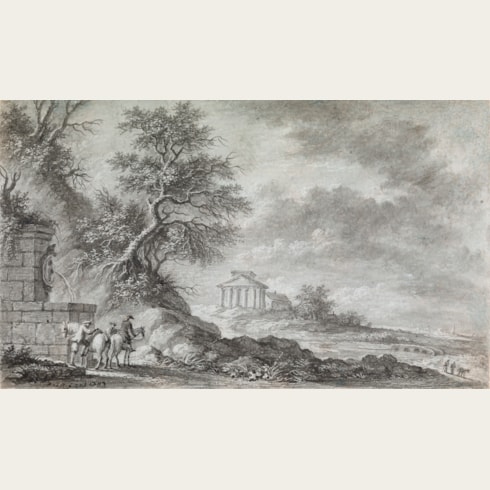Aignan-Thomas DESFRICHES
(Orléans 1715 - Orléans 1800)
Washerwomen by a Lake, a Mill in the Background
Black chalk, brush and grey ink and grey wash, with extensive scratching-out, on prepared grey-blue paper, laid down on a late 18th century mount.
Signed and dated Desfriches 1778 at the lower left.
88 x 147 mm. (3 1/2 x 5 3/4 in.)
Signed and dated Desfriches 1778 at the lower left.
88 x 147 mm. (3 1/2 x 5 3/4 in.)
The present sheet is an example of a particular type of drawing adopted by Desfriches in the latter part of his career. Using a coated grey-blue paper he had invented, known as a 'papier à tablettes', Desfriches produced landscape drawings of marvelous precision and delicacy. These drawings, often mounted on wooden snuffboxes, were regularly presented by the artist to particular friends.
Another small papier à tablette by Desfriches of the same house that is depicted on this sheet, seen from a nearly identical viewpoint but with different staffage and dated the following year, was on the art market in Paris in 1925.
Another, very similar view, dated 1782, was part of the superb collection of 18th century French drawings assembled by Marius Paulme in the late 19th century and dispersed at auction in 1929.
Another small papier à tablette by Desfriches of the same house that is depicted on this sheet, seen from a nearly identical viewpoint but with different staffage and dated the following year, was on the art market in Paris in 1925.
Another, very similar view, dated 1782, was part of the superb collection of 18th century French drawings assembled by Marius Paulme in the late 19th century and dispersed at auction in 1929.
Aignan-Thomas Desfriches studied in his native Orléans before moving in 1733 to Paris, where he completed his artistic training in the studios of first Nicolas Bertin and later Charles-Joseph Natoire. He became the director of the drawing academy established under the patronage of the duc de Rohan-Chabot, but returned to Orléans at the end of the 1730s to take over his father’s spice importing business. He worked in Orléans for the remainder of his career, and founded the Ecole de Peinture, de Sculpture et d’Architecture d’Orléans in 1786. Active primarily as a landscape painter and draughtsman, Desfriches was strongly influenced by the Dutch masters of the 17th century. He first visited the Netherlands in 1753, and began collecting Dutch paintings and drawings soon afterwards, buying many works on a second trip in 1766. Indeed, he was particularly active as a collector, and by 1778 the inventory of his collection listed a total of 114 paintings and sculptures, as well as between two and three hundred drawings. A portion of his collection was given by his widow to the Musée des Beaux-Arts in Orléans in 1824.
As a draughtsman, Desfriches produced charming landscapes of the countryside around Orléans and the valley of the river Loire and its tributaries, peopled by acutely observed peasants and travellers. Prominent among a large number of topographical drawings is a vast panorama of the city of Orléans, now in the collection of the Musée des Beaux-Arts there. In the latter part of his career, Desfriches adopted the practice of drawing on a coated grey-blue paper he had invented, known as papier-tablette, producing landscape drawings of marvellous precision and delicacy. These small drawings, often mounted on wooden snuffboxes, were regularly presented by the artist to particular friends.
Provenance
Anonymous sale, London, Sotheby’s, 14 April 1999, part of lot 119
P. & D. Colnaghi, London, in 1999
Private collection, Middlesex
Thence by descent.
P. & D. Colnaghi, London, in 1999
Private collection, Middlesex
Thence by descent.
Literature
Peter Bower, ‘Aignan-Thomas Desfriches (1715-1800) and his Papier a Tablette and a Later Development of His Technique’, The Quarterly: The Journal of the British Association of Paper Historians, April 2019, pp.30-31, fig.3.






